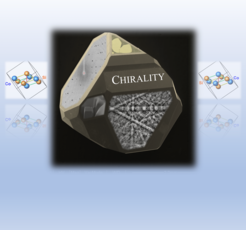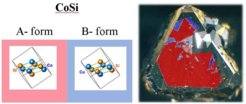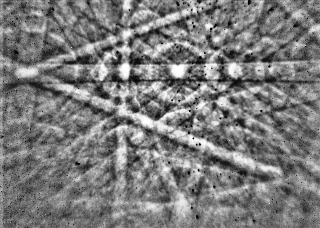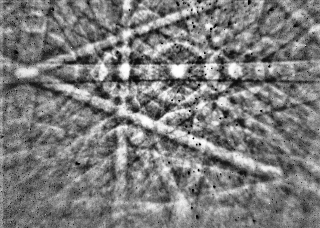Absolute Structure from Scanning Electron Microscopy

Non-centrosymmetry is a fascinating topic because crystalline materials with chiral crystal structures exist in two enantiomorphic forms i.e. with different absolute structures which are in many respects identical but show different handedness. Well known examples are both forms of a-quartz with left- and right-handed chirality in which the crystal structures show opposite screw axes. The lack of a center of symmetry in the crystal structure may influence physical and chemical properties or is even mandatory like for optical birefringence or ferroelectricity with divers technically relevant applications. The investigation of such behavior can be challenging due to possible impact of microstructure effects. Opposite properties of both enantiomorphs may alter or even cancel out physical effects if domains with different chirality are parts of the microstructure.
One focus of the actual research in the Department Chemical Metal Science is the spatially resolved assignment of chirality by using electron backscatter diffraction (EBSD) in a scanning electron microscope. Together with Dr. Aimo Winkelmann from the AGH university Krakow, advanced Kikuchi pattern simulation which includes dynamic multi-scattering processes is applied to assign the chirality of single grains in a microstructure by a quantitative comparison between experimental and simulated EBSD patterns. Chirality sensitivity of EBSD patterns is shown in our experiments by comparison of patterns from domains with the same crystallographic orientation but different chirality. These differences are highly consistent with the mismatch between related simulated patterns. Special care has been taken to prove the correct assignment of chirality from Kikuchi pattern evaluation, and this determined the concept of the experimental realization. Here, high quality single crystals of the non-centrosymmetric phase CoSi (FeSi type of structure, space group P213) were prepared by chemical vapor transport. Two agglomerated crystals with a common interface were selected for metallographic preparation. Kikuchi pattern evaluations and the determination of the absolute structure of both crystals from single crystal X-ray diffraction data reveal consistently different chirality of both crystals. Focused ion beam technique was used to cut out cube-shaped fragments suitable for X-ray diffraction experiments on both sides of the interface and guaranteed the analyses of the same material by both diffraction methods.
The presented combination of EBSD and X-ray diffraction methods together with focused ion beam technique is a promising procedure to investigate non-centrosymmetry and the impact of the microstructure.
UB / CPfS

Both absolute structures (A- and B-form) of CoSi with different chirality are related to the color-coded domains on the surface of the CoSi crystallite (light optical image; edge length 1.4 mm).

EBSD patterns from both color-coded domains (alternate presentation) visualize the chirality dependent differences.













